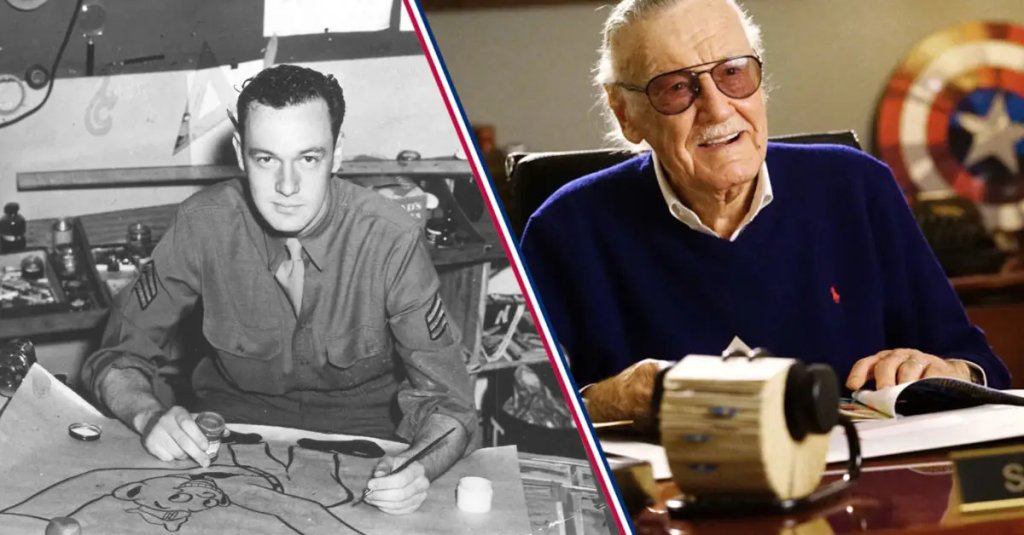

This weekend, comic book fans all over the world were saddened by the terrible news that the father of superheroes had passed — and veterans lost a brother-in-arms who dedicated his life to the arts. This week, the Army Signal Corps says farewell to its most prominent member.
Stan Lee, WWII veteran, comic-book author, and editor-in-chief at Marvel Comics, passed away on the morning of November 12, 2018. As painful as this news is to his family, friends, and fans around the world, we can all appreciate the fact that his life was a very accomplished one. The only way to truly honor a man so great is by reflecting on his storied life and “rise ever upward.” Or, as he’d put it, in it’s Latin form, “excelsior!“

(Marvel Comics)
Stan Lee, born Stanley Martin Lieber, began his career in the comic book world in 1939 when he took on a position as an assistant at Timely Comics under Joe Simon. It wasn’t an easy job, but it needed doing. He’d get people lunch, make sure everyone’s inkwells were full, and even do some proofreading — these weren’t glamorous duties, but they kept the wheels turning. When he finally touched the comic book world directly, he changed it forever — he was given a small amount of creative control over Captain America #3, and he used it to give Cap his signature shield ricochet.

(U.S. Army)
What was nothing more than a small writer’s credit at the time gave rise to immense goals. From that moment forward, Lee set out to create the next “Great American Novel.” As we all know, this ambition eventually morphed and developed into the greater Marvel Universe, a web of fictions that has today touched the lives of millions across the globe. But this lofty goal wasn’t outside of the scope of reality for a 19-year old Stan Lee — he believed in himself.
By then, World War II was heating up and Lee found himself enlisted in the Army by early 1942. Soon after that, he was at Fort Monmouth, New Jersey, learning to string and repair communication lines. In his downtime, he’d continue to draw and write to help pass the time.
It wasn’t long until the Army realized that they needed to create training films to onboard the massive influx of new troops. Because of the highly-sensitive nature of the process, they couldn’t trust just anyone to create them — they needed soldiers. The Army began its Signal Corps Photographic Center at Fort Monmouth, which, coincidentally, was where Lee was stationed.
Lee’s superior officers recognized his creative talents from his hobbies and his earlier work with Timely Comics. So, they more or less hey-you’d him into using his talents for the Army. This was exactly the break he needed. He was laterally transferred to the Fort Monmouth Film Production Laboratory and worked side by side with some of the other greatest artistic visionaries of the U.S. Army.
He stood in formation with Frank Capra, the three-time Academy-Award-winning director for films like It’s a Wonderful Life, cartoonist Charles Addams of The Addams Family fame, and Theodor Geisel, better known as Dr. Seuss. Lee was one of nine soldiers to ever earn the position of “playwright” for the U.S. Army.
Lee didn’t have any notoriety before then, unlike many of his famous fellow soldiers. He was, simply, that guy who wrote for comic books, but that didn’t phase him one bit. He kept giving the Army his all — and it showed. He was so good and so fast at what he did, in fact, that he was asked to slow down many times because it made everyone else look bad.

(Walt Disney Studios)
Lee’s service concluded in 1945 and he went back to Timely Comics. No longer was he just some kid grabbing coffee; he was a war hero. The skills he developed while quickly chugging out quality content for the Army was exactly the type of tempo needed in the comic world.
Lee used his Army experiences to perfect comic book making. He turned the process into a creative assembly line. Lee would write the captions in the bubbles, another artist would pencil in the scene, another would color it, and another would finalize the lettering. This style became known as the “Marvel Method.” It distributed the workload evenly and it gave everyone equal creative input.
Stan Lee may not have written the next Moby Dick as he planned while a bright-eyed 19-year-old, but there’s no denying that his life’s work — the Marvel Universe — stands tall as the most enduring, relevant collection of fiction of his era.
Rest easy, Mr. Lee. You made True Believers out of all of us.
